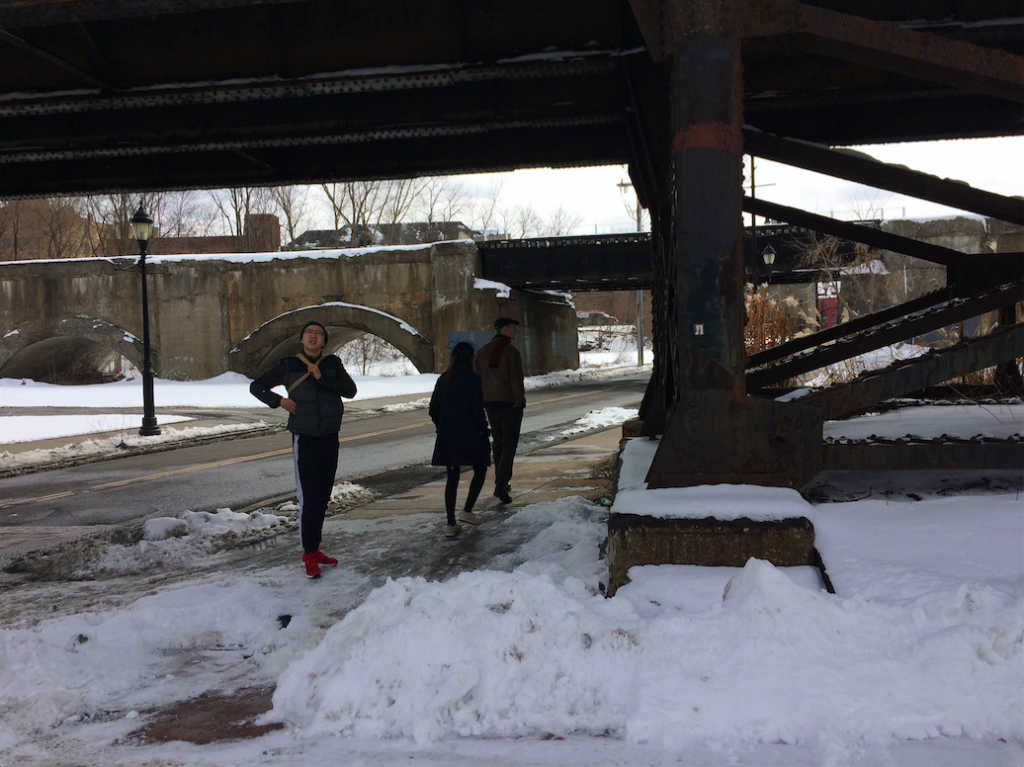
Immerse yourself in the history of Downtown Binghamton at the Binghamton Historic Soundwalk Project, a community-based event that uses sound to exhibit the city’s past and present.
Directed by Jennifer Stoever, an associate professor of English, and Monteith McCollum, an assistant professor of cinema, the project will debut a one-mile guided walk starting from the Center for Technology & Innovation, also known as TechWorks!, located on Water Street. According to Stoever, a soundwalk is a trip that emphasizes your awareness of sound while connecting you with the environment. For those who wish to walk at their own pace, the soundwalk route will also be available as a map that can be accessed online.
The event will take walkers to four different sites, all of which showcase an important part of the city’s history, ranging from the Native American settlement near the Susquehanna River to the public dances held at Boscov’s in the 1980s. Each site also includes exhibitions made by Binghamton University students who are taking Stoever and McCollum’s class, ENG 450P: Sound, Places and Publics. The goal of the class is for students to learn about the history of the city of Binghamton while constructing sound art — installations of auditory compositions or recordings — for the project.
According to Stoever, those on the walk should take in the sounds of the surrounding nature to gain the full effect of the project.
“For our soundwalk here, we’re gonna ask residents and students going to walk with us to just listen,” Stoever said. “They should think about how listening helps us locate ourselves physically in space but also emotionally in space.”
Xueji Fan, a senior majoring in cinema, worked with her group on an exhibition titled “stitches,” which focuses on the hardships of women laborers in the Binghamton area in the 19th and early 20th century.
For “stiches,” exhibition listeners sit in front of a large transparent sheet that shows the shadow of a fence, representing how real Binghamton-area factories looked during the time period. The echoes of female voices and factory machinery then fill the atmosphere, showcasing historical events including the 1913 Binghamton factory fire and the Binghamton cigar workers’ strike of 1890. The sounds used in her group’s exhibition were either found in archives or recorded by current female employees of Boscov’s, who read old codes from women workers from the past.
Fan said the Binghamton Historic Soundwalk Project is an opportunity for students to connect with their community.
“Since we’re doing this in old places [that] no longer exist, it’s a good chance for them to listen to our pieces and to see the contemporary of that site and what we did that can associate with the past,” Fan said.
Jesse Williams, a sophomore double-majoring in cinema and comparative literature, and his group created an exhibition called “No Parking on the Dancefloor,” a piece that transforms Boscov’s parking ramp into a 1980s dance party. The sounds in the project are made mostly by the group members, who recreated the sounds of people dancing, like feet tapping and shuffling.
“No Parking on the Dancefloor” is based on the Binghamton-founded American Dance Asylum, an organization that grew popular in the ’80s with its avant-garde public dances held in the parking ramp. These dances encouraged all people to dance, regardless of their body type, gender or sexuality.
“The dances were a way to not just have creative collaboration between the town and the campus, but also as activism challenging the silence around AIDS and homophobia,” Stoever said. “They’re a real piece of queer history in Binghamton that we often don’t think about.”
“Hydro Impressions,” an installation created by Jacob Lazen, a senior majoring in anthropology, and his group members, take listeners back to the time when Native Americans lived on the banks of the Susquehanna River. To imitate the sounds of the river flowing, Lazen and his team used three tin pans filled with water vibrating at different patterns.
Lazen said he learned how to create the mechanisms in his project solely through practice and that an engineering background isn’t necessary to contribute to the soundwalk.
“I’m an anthropology major, so I have zero background in engineering but a lot of background in music production,” Lazen said. “It’s just a question of learning where things plug in and how to touch wire together, so this isn’t like Watson.”
The walk ends back at TechWorks!, where Shane Smith and Brandon Barrett, both seniors majoring in cinema, feature their project called “Resonant Technologies.” The project is a mini soundwalk inside the factory that includes three different sonic installations, ranging from the art of typewriters to sounds of telegraphic Morse code.
“Before I took this class, sound wasn’t even in my ideas of an art installation, and I didn’t think sound and history could be so connected,” Barrett said.
The Binghamton Soundwalk Project will take place from 6 p.m. to 9 p.m. at TechWorks! at 321 Water St. The walks will leave every 30 minutes from TechWorks!.


